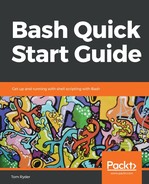Most of the time when programming in Bash, you will not actually want to test $? directly, but instead test it implicitly as success or failure, with language features in Bash itself.
If you wanted to issue a set of commands on one command line, but only to continue if every command worked, you would use the double-ampersand (&&) control operator, instead of the semicolon (;):
$ cd && rmdir ~/nonexistent && ls
When we run this command line, we see that the final ls never runs, because the rmdir command before it failed:
rmdir: failed to remove '/home/user/nonexistent': No such file or directory
Similarly, if we changed the cd command at the start of the command line to change into a directory that didn't exist, the command line would stop even earlier:
bash$ cd ~/nonexistent && rmdir ~/nonexistent && ls bash: cd: /home/bashuser/nonexistent: No such file or directory
In Chapter 6, Loops and Conditionals, we'll explore more fully Bash's options for control flow, including using the || command separator, and using the if command to execute blocks of code conditional on a test outcome.
